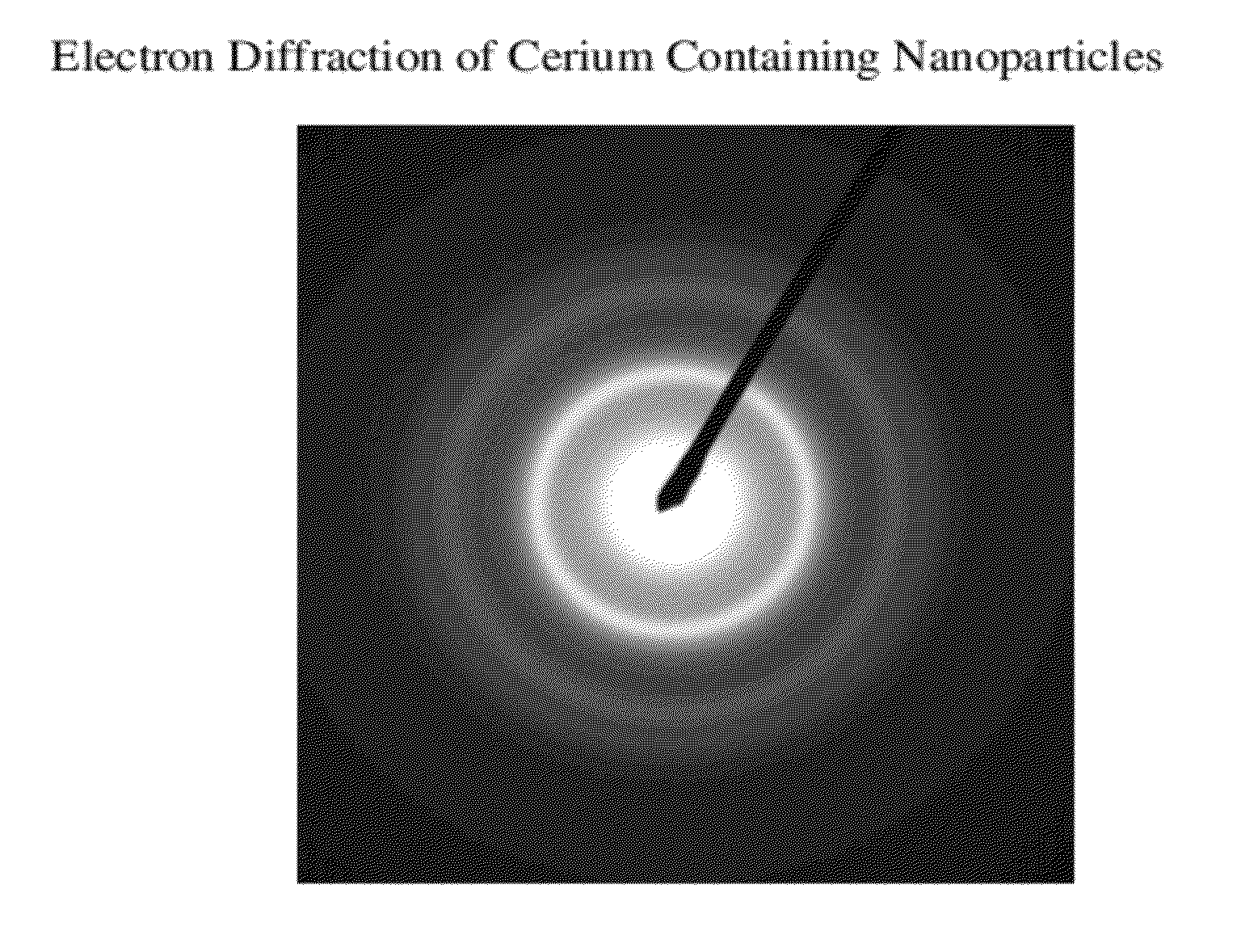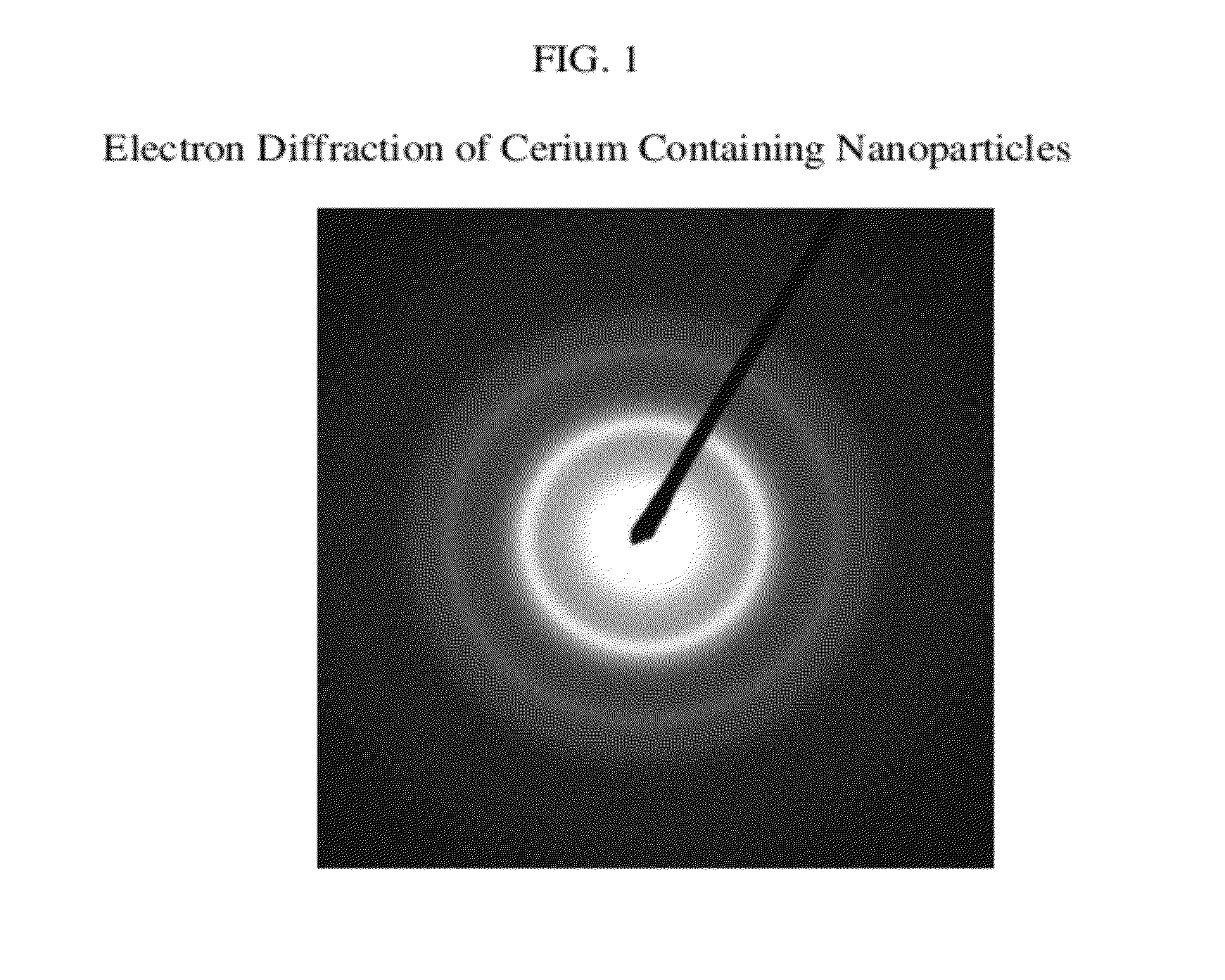Cerium containing nanoparticles prepared in non-polar solvent
a nanoparticle and non-polar solvent technology, applied in zirconium compounds, lanthanide oxides/hydroxides, fuels, etc., can solve the problems of inability to stabilize in a non-polar environment, inconvenient aqueous process, and inability to meet the requirements of non-polar environment stabilization, etc., to achieve efficient yield, reduce solvent shifting steps, and facilitate manufacturing
- Summary
- Abstract
- Description
- Claims
- Application Information
AI Technical Summary
Benefits of technology
Problems solved by technology
Method used
Image
Examples
example 1
oparticles Prepared in Octanoic Acid at 220° C.
[0052]A 50 cc beaker was charged with 9.00 g octanoic acid. Then 3.00 g cerium(III) acetate hydrate ((CH3CO2)3Ce·xH2O) powder (7.15:1 molar ratio of octanoic acid:cerium) was added at room temperature. The mixture was stirred with no apparent reaction, so the beaker was heated on a hot plate. As the temperature within the beaker neared about 100° C., the color of the mixture turned to a light yellow. Upon further heating, acetic acid (bp 118° C.) and H2O vapor appeared to boil off. The reaction mixture was eventually ramped to 220° C. over a period of 1 hr, during which the yellow color became much deeper, nearly amber. Upon cooling the reaction product became viscous, although substantially less viscous than the reaction product of Example 4 described below, wherein oleic acid was used as the solvent.
[0053]A spot of the viscous reaction product was diluted in toluene and dried down onto a TEM grid. Subsequently the grid was soaked in a...
example 2
cles Prepared in 2× Octanoic Acid and 1-Octadecene Solvent
[0056]A 100 cc round-bottom flask was charged with 18.0 g octanoic Acid, 550 g 1-octadecene and a magnetic stir bar. Then 3.00 g cerium(III) acetate hydrate ((CH3CO2)3Ce·xH2O) powder (14.3:1 molar ratio of octanoic acid:cerium) was added at room temperature. The clear mixture was stirred with no apparent reaction, so the beaker was heated using a heating mantle. As the temperature within the beaker neared about 100° C., the color of the mixture turned to a light yellow. All solids were dissolved. The temperature of the reaction mixture was ramped to 200° C. over a 1 hr. period, and then held there for 2 hr. During this final heating, the reaction mixture deepened to an amber / brown color.
[0057]ISOPAR™-G was added to a sample of the reaction mixture, which fully dissolved. This dispersion showed no evidence of any precipitate when examined on the next day. Thus, this preparation resulted in a more stable dispersion in a non-pol...
examples 3-5
Using A Higher-Boiling Unsaturated Ccarboxlic Acid, Oleic Acid
PUM
| Property | Measurement | Unit |
|---|---|---|
| geometric diameter | aaaaa | aaaaa |
| size | aaaaa | aaaaa |
| atomic numbers | aaaaa | aaaaa |
Abstract
Description
Claims
Application Information
 Login to View More
Login to View More - R&D
- Intellectual Property
- Life Sciences
- Materials
- Tech Scout
- Unparalleled Data Quality
- Higher Quality Content
- 60% Fewer Hallucinations
Browse by: Latest US Patents, China's latest patents, Technical Efficacy Thesaurus, Application Domain, Technology Topic, Popular Technical Reports.
© 2025 PatSnap. All rights reserved.Legal|Privacy policy|Modern Slavery Act Transparency Statement|Sitemap|About US| Contact US: help@patsnap.com



